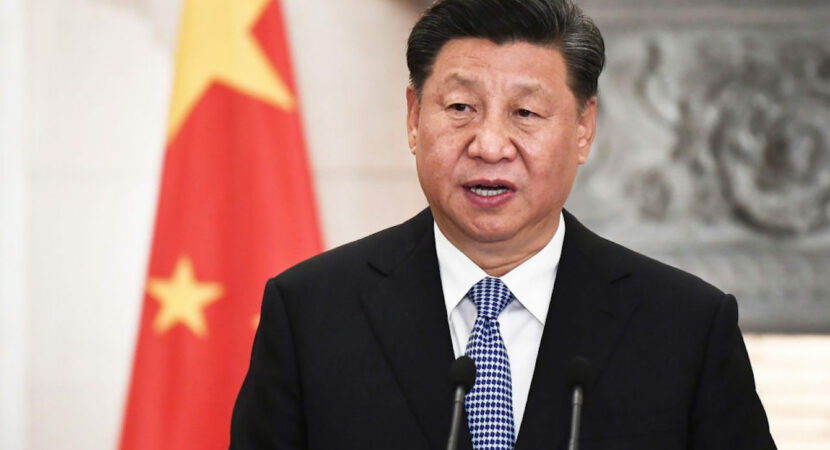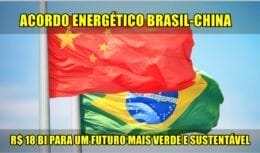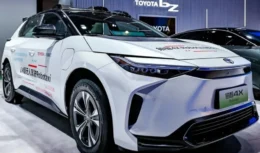
It ends a period of more than two decades of strangulation in China. Chinese government releases European, Japanese and American giants for commercial participation in the largest market in the world!
The battered Brazilian automotive industry, affected by the global crisis of chip shortages and the coronavirus pandemic, will suffer very hard consequences from the opening of the sector in China. The Chinese government ended restrictions on foreign automakers in their own businesses in the country. The news was confirmed by the Ministry of Commerce and the National Development and Reform Commission (NDRC) of China, on the 28th, and came into effect from January 1, 2022.
Read also
- The largest wind turbine in the world will be Chinese: wind turbines that China plans to use in the construction of its most ambitious wind farm are more powerful than General Electric's Haliade-X
- Eike signs a partnership with China and gains 'infinite' capital to put oil and gas, mining, renewable energy and infrastructure projects into practice in Brazil
- China wants to bring down oil prices by force
- The largest and first offshore converter station in the world has been installed! The 22000-ton, 15-story steel giant house will supply electricity to 1,36 million homes in China
- China defies Google and builds the world's most powerful quantum computer
- 91,3 thousand tons of nickel, a fundamental raw material used in the production of batteries for electric vehicles, produced in Bahia, were exported to China by the only producer of the ore in Brazil, Atlantic Nickel
The measure ends a period of almost 30 years of strangulation in China. Now, the giant European, Japanese and American vehicle manufacturers will have greater participation in the largest market in the world, the Chinese!
China had legislation known as the “50:50 rule”
27 years ago, China maintained legislation known as the “50:50 rule”, the domestic norm provided, since 1994, that foreign automakers that set up in the country could only do so through local partners, never holding more than 50% of the share control of the operation. are the calls joint ventures.
“With the end of this barrier, multinationals will gain independence, while Chinese companies will lose the cash flow that comes from these joint ventures, gradually”, predicts the Automotive Foresight analyst.
At the time, the “50:50 rule” aimed to protect the Chinese automotive industry, allowing it to have access to cutting-edge technology, at the hands of foreign multinationals, allowing the sector to consolidate nationally, before giving unrestricted access to its market to global giants.
With the “50:50 rule”, the multinational vehicle manufacturers that set up shop in China have, in recent years, downsized their industrial areas. Hyundai, for example, closed two of its seven Chinese plants. We can also mention PSA Peugeot-Citroën (now part of Stellantis, together with FCA Fiat-Chrysler) which closed its j with Changan Automobile and reduced its production volumes in partnership with Dongfeng.
China, que terá o maior PIB (Produto Interno *****) do mundo consolidado, em 2030, projeta fabricar 30 milhões de veículos para 2025 e afetará toda a indústria mundial automotiva
China, which 35 years ago had a GDP smaller than Brazil and a share in foreign trade equivalent to half that of Brazil, aims to grow to 30 million cars per year in 2025, and the Chinese market continues to trample North Americans, British and Japanese.
Apesar da nova legislação, muitas multinacionais estrangeiras já anunciaram que pretendem manter a parceria com as montadoras chinesas, sem as quais não teriam os suportes técnico e de suprimentos de que dependem. Nunca é demais lembrar que a China terá o maior PIB (Produto Interno *****) do mundo consolidado, em 2030.
“Foreign brands have already realized that they are walled off. If, on the one hand, the shareholding control will give them a larger share in the division of profits, on the other hand, they find themselves very dependent on Chinese partners. There is no way to break the ties”, pointed out the head of consulting at IHS Markit for Asia and the Pacific, James Chao, to the agency. Reuters.
“I think for most people joint ventures, there will not be a quick change soon after the opening, as there are still long-term contracts to be fulfilled”, ponders Wang Cun, from the Chinese Association of Vehicle Distributors.
“Today, the Chinese market is not only the largest in the world, but also the most competitive, and we see domestic brands such as BYD and Geely gaining ground, while the share of many joint ventures is decreasing”, he adds.
In 2018, China released its market for electric model manufacturers and Tesla began its marriage with the Beijing government
It is worth mentioning that, since 2018, China had already opened its market to electric model manufacturers. It was in July of that year that Tesla began its marriage with the government of Beijing and, since then, the country has received large foreign investments to set up factories dedicated to electromobility.
“In this segment, we noticed a very important advance, either in the products developed and produced by joint ventures, whether in the price policy that has been constantly pressuring Chinese manufacturers to be more competitive”, emphasizes the general secretary of the local Association of Passenger Cars (equivalent to the Brazilian Anfavea), Cui Dongshu.
Proof of this is that, in 2020, Mercedes-Benz and Geely announced a j global initiative for the electrification of the Smart brand.
Global giants vehicle manufacturers Volkswagen, General Motors, Toyota, Mercedes-Benz and BMW target Chinese automotive market and may leave Brazil
"Groups like Volkswagen and General Motors are very happy, after all, they will no longer have to share 50% of their profits with their local partners", said the analyst of the consultancy Automotive Foresight, Yale Zhang, directly from Shanghai, to the newspaper Industry Week.
It is likely that, with the new rule, foreign multinationals in the sector will focus on the Chinese market, leaving countries like Brazil even more adrift, where sales are still poor and without a prospect of recovery.
“The equity game starts in earnest here,” he declared to Global Times the director of the import committee of the Chinese Association of Vehicle Distributors (kind of Fenabrave from there), Wang Cun.
“We will still see many negotiations and the allocation of capital will depend on the format of each of these joint ventures”, he added, making it clear that the flow of investment from the giants in the sector will be diverted to China.
For Wang, brands such as Mercedes-Benz and BMW will take advantage of their prestige and technological power to take greater and greater control of their own businesses.
“We received the opening of this market and other reforms as a new welcome gesture. Over the past 18 years, we have been very successful in the country, thanks to the support of the Chinese authorities and the commitment of the government of Liaoning Province – which is located in northeast China – which are the cornerstone of our business”, said the chairman of the group’s Board of Management, Oliver Zipse, in an official statement.
General Motors said, in an official statement, that “its growth in China is the result of working with partners in joint venturee, and that it will continue with them. Trust and work with our partners is what allows us to provide high quality products and services to Chinese consumers.”
Another giant global vehicle manufacturer, Honda, said through an adviser that it does not even intend to change the ownership structure of its operation in China: "At the moment, we have no plans to change our capital ratio".
Toyota is another foreign multinational that has made it clear that it has no plans to explore new local partners or seek to establish an exclusive business in China. Today, the Japanese brand has two Chinese state partners, FAW and GAC.
by – mobiauto













Not to salute a thief...
Fabiano Barbosa da Silva coordinated in any…
Distribution assistance
How do you do it, send Coricolo
I fully agree... Cuba is a symbol of...
How about correcting this article title…
Moto Aparti 160 must have 6…
Very interesting!!It is aiming at the cool environment